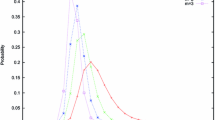Abstract
In the present paper, we study the distribution of a statistic utilizing the runs length of “reasonably long” series of alike elements (success runs) in a sequence of binary trials. More specifically, we are looking at the sum of exact lengths of subsequences (strings) consisting ofk or more consecutive successes (k is a given positive integer). The investigation of the statistic of interest is accomplished by exploiting an appropriate generalization of the Markov chain embedding technique introduced by Fu and Koutras (1994,J. Amer. Statist. Assoc.,89, 1050–1058) and Koutras and Alexandrou (1995,Ann. Inst. Statist. Math.,47, 743–766). In addition, we explore the conditional distribution of the same statistic, given the number of successes and establish statistical tests for the detection of the null hypothesis of randomness versus the alternative hypothesis of systematic clustering of successes in a sequence of binary outcomes.
Similar content being viewed by others
References
Agin, M. A. and Godbole, A. P. (1992). A new exact runs test for randmness,Computing Science and Statistcs (eds. C. Page and R. Le Page), 281–285, Proceedings of the 22 Symposium on the Interface, Springer, New York.
Aki, S. and Hirano, K. (1988). Some characteristics of the binomial distribution of orderk and related distributions,Statistical Theory and Data Analysis II (ed. K. Matusita), 211–222, Elsevier Science, North-Holland.
Antzoulakos, D. L. and Chadjiconstantinidis, S. (2001). Distributions of numbers of success runs of fixed length in Markov dependent trials,Ann. Inst. Statist. Math.,53, 599–619.
Balakrishnan, N. and Koutras, M. V. (2002).Runs and Scans with Applications, Wiley, New York.
Balakrishnan, N., Balasubramanian, K. and Viveros, R. (1993). On sampling inspection plans based on the theory of runs,Math. Sci.,18, 113–126.
Balakrishnan, N., Balasubramanian, K. and Viveros, R. (1995). Start-up demonstration tests under correlation and corrective action,Naval Res. Logist.,42, 1271–1276.
Balakrishnan, N., Mohanty, S. G. and Aki, S. (1997). Start-up demonstration tests under Markov dependence model with corrective actions,Ann. Inst. Statist. Math.,49, 155–169.
Barbour, A. D., Holst, L. and Janson, S. (1992).Poisson Approximations, Oxford University Press, New York.
Bradley, J. (1968).Distribution Free Statistical Tests, Prentice Hall, New Jersey.
Chao, M. T., Fu, J. C. and Koutras, M. V. (1995). A survey of the reliability studies of consecutive-k-out-of-n: F systems and its related systems,IEEE Transactions on Reliability,44, 120–127.
Doi, M. and Yamamoto, E. (1998). On the joint distribution of runs in a sequence of multi-state trials,Statist. Probab. Lett.,39, 133–141.
Fu, J. C. (1996). Distribution theory of runs and patterns associated with a sequence of multistate trials,Statist. Sinica,6, 957–974.
Fu, J. C. and Koutras, M. V. (1994). Distribution theory of runs: a Markov chain approach,J. Amer. Statist. Assoc.,89, 1050–1058.
Gibbons, J. D. and Chakraborti, S. (1992).Nonparametric Statistical Inference, 3rd ed., Marcel Deker, New York.
Godbole, A. P. (1990). On hypergeometric and related distributions of orderk.Comm. Statist. Theory Methods,19, 1291–1301.
Godbole, A. P. (1992). The exact and asymptotic distribution of overlapping success runs,Comm. Statist. Theory Methods,21, 953–967.
Hahn, G. J. and Gage, J. B. (1983). Evaluation of a start-up demonstration test,Journal of Quality Technology,15, 103–105.
Han, Q. and Aki, S. (1999). Joint distributions of runs in a sequence of multistate trials,Ann. Inst. Statist. Math.,51, 419–447.
Hirano, K. and Aki, S. (1993). On number of occurrences of success runs of specified length in a two-state Markov chain,Statist. Sinica,3, 313–320.
Hirano, K., Aki, S., Kashiwagi, N. and Kuboki, H. (1991). On Ling's binomial and negative binomial distributions of orderk, Statist. Probab. Lett.,11, 503–509.
Koutras, M. V. (1997). Waiting time distributions associated with runs of fixed length in two-state Markov chains,Ann. Inst. Statist. Math.,49, 123–139.
Koutras, M. V. and Alexandrou, V. A. (1995). Runs, scans and urn model distributions: A unified Markov chain approach,Ann. Inst. Statist. Math.,47, 743–766.
Koutras, M. V. and Alexandrou, V. A. (1997). Nonparametric statistical randomness tests based on success runs of fixed length,Statist. Probab. Lett.,32, 393–404.
Mosteller, F. (1941). Note on an application of runs to quality control charts,Ann. Math. Statist.,12, 228–232.
O'Brien, P. C. and Dyck, P. J. (1985). A runs test based on run lengths,Biometrics,41, 237–244.
Panaretos, J. and Xekalaki, E. (1986). On generalized binomial and multinomial distributions and their relation to generalized Poisson distributions,Ann. Inst. Statist. Math.,38, 223–231.
Philippou, A. N. and Makri, F. S. (1986). Success runs and longest runs,Statist. Probab. Lett.,4, 211–215.
Philippou, A. N., Antzoulakos, D. L. and Tripsiannis, G. A. (1990). Multivariate distributions of orderk, Part II,Statist. Probab. Lett.,10, 29–35.
Stanley, R. P. (1997).Enumerative Combinatorics, Vol. I, Cambridge University Press.
Steyn, H. S. (1956). On the univariate seriesF(t)=F(a; b 1, b2, ..., bk; t, t2, ..., tk) and its applications in probability theory,Proc. Konink. Nederl. Akad. Wetensch. Ser. A.,59, 190–197.
Viveros, R. and Balakrishnan, N. (1993). Statistical inference from start-up demonstration test data,Journal of Quality Technology,25, 119–130.
Wolfowitz, J. (1943). On the theory of runs with some applications to quality control,Ann. Math. Statist.,14, 280–288.
Author information
Authors and Affiliations
Additional information
Research supported by General Secretary of Research and Technology of Greece under grand PENED 2001.
About this article
Cite this article
Antzoulakos, D.L., Bersimis, S. & Koutras, M.V. On the distribution of the total number of run lengths. Ann Inst Stat Math 55, 865–884 (2003). https://doi.org/10.1007/BF02523398
Received:
Revised:
Issue Date:
DOI: https://doi.org/10.1007/BF02523398




